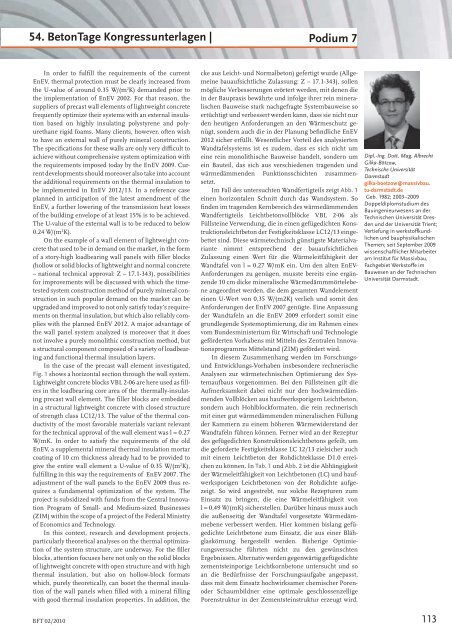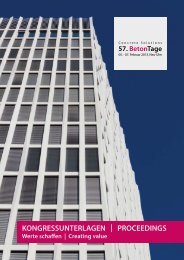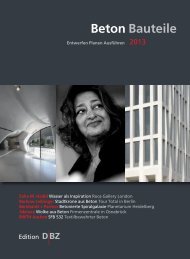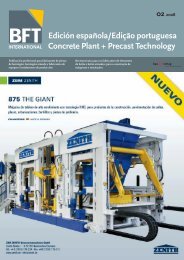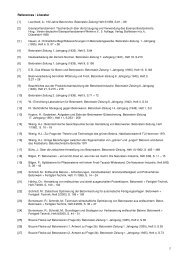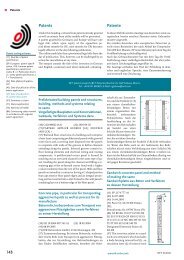Concrete Plant + Precast Technology Betonwerk ... - BFT International
Concrete Plant + Precast Technology Betonwerk ... - BFT International
Concrete Plant + Precast Technology Betonwerk ... - BFT International
Erfolgreiche ePaper selbst erstellen
Machen Sie aus Ihren PDF Publikationen ein blätterbares Flipbook mit unserer einzigartigen Google optimierten e-Paper Software.
54. BetonTage Kongressunterlagen |<br />
In order to fulfi ll the requirements of the current<br />
EnEV, thermal protection must be clearly increased from<br />
the U-value of around 0.35 W/(m 2 K) demanded prior to<br />
the implementation of EnEV 2002. For that reason, the<br />
suppliers of precast wall elements of lightweight concrete<br />
frequently optimize their systems with an external insulation<br />
based on highly insulating polystyrene and polyurethane<br />
rigid foams. Many clients, however, often wish<br />
to have an external wall of purely mineral construction.<br />
The specifi cations for these walls are only very diffi cult to<br />
achieve without comprehensive system optimization with<br />
the requirements imposed today by the EnEV 2009. Current<br />
developments should moreover also take into account<br />
the additional requirements on the thermal insulation to<br />
be implemented in EnEV 2012/13. In a reference case<br />
planned in anticipation of the latest amendment of the<br />
EnEV, a further lowering of the transmission heat losses<br />
of the building envelope of at least 15% is to be achieved.<br />
The U-value of the external wall is to be reduced to below<br />
0.24 W/(m 2 K).<br />
On the example of a wall element of lightweight concrete<br />
that used to be in demand on the market, in the form<br />
of a story-high loadbearing wall panels with fi ller blocks<br />
(hollow or solid blocks of lightweight and normal concrete<br />
– national technical approval: Z – 17.1-343), possibilities<br />
for improvements will be discussed with which the timetested<br />
system construction method of purely mineral construction<br />
in such popular demand on the market can be<br />
upgraded and improved to not only satisfy today’s requirements<br />
on thermal insulation, but which also reliably complies<br />
with the planned EnEV 2012. A major advantage of<br />
the wall panel system analyzed is moreover that it does<br />
not involve a purely monolithic construction method, but<br />
a structural component composed of a variety of loadbearing<br />
and functional thermal insulation layers.<br />
In the case of the precast wall element investigated,<br />
Fig. 1 shows a horizontal section through the wall system.<br />
Lightweight concrete blocks VBL 2-06 are here used as fi llers<br />
in the loadbearing core area of the thermally-insulating<br />
precast wall element. The fi ller blocks are embedded<br />
in a structural lightweight concrete with closed structure<br />
of strength class LC12/13. The value of the thermal conductivity<br />
of the most favorable materials variant relevant<br />
for the technical approval of the wall element was l = 0.27<br />
W/mK. In order to satisfy the requirements of the old<br />
EnEV, a supplemental mineral thermal insulation mortar<br />
coating of 10 cm thickness already had to be provided to<br />
give the entire wall element a U-value of 0.35 W/(m 2 K),<br />
fulfi lling in this way the requirements of EnEV 2007. The<br />
adjustment of the wall panels to the EnEV 2009 thus requires<br />
a fundamental optimization of the system. The<br />
project is subsidized with funds from the Central Innovation<br />
Program of Small- and Medium-sized Businesses<br />
(ZIM) within the scope of a project of the Federal Ministry<br />
of Economics and <strong>Technology</strong>.<br />
In this context, research and development projects,<br />
particularly theoretical analyses on the thermal optimization<br />
of the system structure, are underway. For the fi ller<br />
blocks, attention focuses here not only on the solid blocks<br />
of lightweight concrete with open structure and with high<br />
thermal insulation, but also on hollow-block formats<br />
which, purely theoretically, can boost the thermal insulation<br />
of the wall panels when fi lled with a mineral fi lling<br />
with good thermal insulation properties. In addition, the<br />
<strong>BFT</strong> 02/2010<br />
Podium 7<br />
cke aus Leicht- und Normalbeton) gefertigt wurde (Allgemeine<br />
bauaufsichtliche Zulassung: Z – 17.1-343), sollen<br />
mögliche Verbesserungen erörtert werden, mit denen die<br />
in der Baupraxis bewährte und infolge ihrer rein mineralischen<br />
Bauweise stark nachgefragte Systembauweise so<br />
ertüchtigt und verbessert werden kann, dass sie nicht nur<br />
den heutigen Anforderungen an den Wärmeschutz genügt,<br />
sondern auch die in der Planung befi ndliche EnEV<br />
2012 sicher erfüllt. Wesentlicher Vorteil des analysierten<br />
Wandtafelsystems ist es zudem, dass es sich nicht um<br />
eine rein monolithische Bauweise handelt, sondern um<br />
ein Bauteil, das sich aus verschiedenen tragenden und<br />
wärmedämmenden Funktionsschichten zusammensetzt.<br />
Im Fall des untersuchten Wandfertigteils zeigt Abb. 1<br />
einen horizontalen Schnitt durch das Wandsystem. So<br />
fi nden im tragenden Kernbereich des wärmedämmenden<br />
Wandfertigteils Leichtbetonvollblöcke VBL 2-06 als<br />
Füllsteine Verwendung, die in einen gefügedichten Konstruktionsleichtbeton<br />
der Festigkeitsklasse LC12/13 eingebettet<br />
sind. Diese wärmetechnisch günstigste Materialvariante<br />
nimmt entsprechend der bauaufsichtlichen<br />
Zulassung einen Wert für die Wärmeleitfähigkeit der<br />
Wandtafel von l = 0,27 W/mK ein. Um den alten EnEV-<br />
Anforderungen zu genügen, musste bereits eine ergänzende<br />
10 cm dicke mineralische Wärmedämmmörtelebene<br />
angeordnet werden, die dem gesamten Wandelement<br />
einen U-Wert von 0,35 W/(m2K) verlieh und somit den<br />
Anforderungen der EnEV 2007 genügte. Eine Anpassung<br />
der Wandtafeln an die EnEV 2009 erfordert somit eine<br />
grundlegende Systemoptimierung, die im Rahmen eines<br />
vom Bundesministerium für Wirtschaft und Technologie<br />
geförderten Vorhabens mit Mitteln des Zentralen Innovationsprogramms<br />
Mittelstand (ZIM) gefördert wird.<br />
In diesem Zusammenhang werden im Forschungs-<br />
und Entwicklungs-Vorhaben insbesondere rechnerische<br />
Analysen zur wärmetechnischen Optimierung des Systemaufbaus<br />
vorgenommen. Bei den Füllsteinen gilt die<br />
Aufmerksamkeit dabei nicht nur den hochwärmedämmenden<br />
Vollblöcken aus haufwerksporigem Leichtbeton,<br />
sondern auch Hohlblockformaten, die rein rechnerisch<br />
mit einer gut wärmedämmenden mineralischen Füllung<br />
der Kammern zu einem höheren Wärmewiderstand der<br />
Wandtafeln führen können. Ferner wird an der Rezeptur<br />
des gefügedichten Konstruktionsleichtbetons gefeilt, um<br />
die geforderte Festigkeitsklasse LC 12/13 zielsicher auch<br />
mit einem Leichtbeton der Rohdichteklasse D1.0 erreichen<br />
zu können. In Tab. 1 und Abb. 2 ist die Abhängigkeit<br />
der Wärmeleitfähigkeit von Leichtbetonen (LC) und haufwerksporigen<br />
Leichtbetonen von der Rohdichte aufgezeigt.<br />
So wird angestrebt, nur solche Rezepturen zum<br />
Einsatz zu bringen, die eine Wärmeleitfähigkeit von<br />
l = 0,49 W/(mK) sicherstellen. Darüber hinaus muss auch<br />
die außenseitig der Wandtafel vorgesetzte Wärmedämmebene<br />
verbessert werden. Hier kommen bislang gefügedichte<br />
Leichtbetone zum Einsatz, die aus einer Blähglaskörnung<br />
hergestellt werden. Bisherige Optimierungsversuche<br />
führten nicht zu den gewünschten<br />
Ergebnissen. Alternativ werden gegenwärtig gefügedichte<br />
zementsteinporige Leichtkornbetone untersucht und so<br />
an die Bedürfnisse der Forschungsaufgabe angepasst,<br />
dass mit dem Einsatz hochwirksamer chemischer Poren-<br />
oder Schaumbildner eine optimale geschlossenzellige<br />
Porenstruktur in der Zementsteinstruktur erzeugt wird.<br />
Dipl.-Ing. Dott. Mag. Albrecht<br />
Gilka-Bötzow,<br />
Technische Universität<br />
Darmstadt<br />
gilka-boetzow@massivbau.<br />
tu-darmstadt.de<br />
Geb. 1982; 2003–2009<br />
Doppeldiplomstudium des<br />
Bauingenieurwesens an der<br />
Technischen Universität Dresden<br />
und der Universität Trient;<br />
Vertiefung in werkstoff kundlichen<br />
und bauphysikalischen<br />
Themen; seit September 2009<br />
wissenschaftlicher Mitarbeiter<br />
am Institut für Massivbau,<br />
Fachgebiet Werkstoff e im<br />
Bauwesen an der Technischen<br />
Universität Darmstadt.<br />
113


